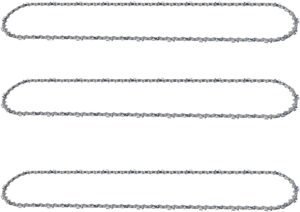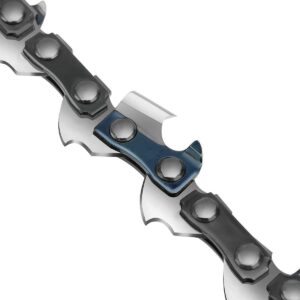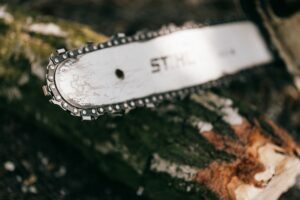
Well, I guess the time has come, your chainsaw’s chain is very dull and you are looking for a replacement chain. Firstly, make sure that you have a complete understanding of the size of the chainsaw’s chain so that you may not end up buying the wrong chain for yourself. For this please visit my article on How to Find Chainsaw Chain Size | 2 Minutes Guide.
After deducing the appropriate size for your chainsaw chain we all wonder which type of chainsaw chain will be best for us. For this, we need to have a complete understanding of different types of chains because through time the chains are being manufactured to give better results and maximize output for specific jobs.
As a result, buying the right chain for your chainsaw will make your work easy and smoother. On the other hand, buying the wrong chain for your chainsaw will make the work even more tedious and backbreaking. For Instance, my friend purchased a diamond-tipped chainsaw chain for household purposes and he ended up injuring his hand because he was having the wrong chain.
Henceforth, we should have a clear and complete understanding of different types of chains. For this purpose, I am writing below a brief guide defining different types of chains and their feature.
Table of Contents
Types Of Chainsaw Chains
The prime difference between the chainsaw’s chain comes because of the following factors.
- The Type Of Cutter Material Of The Chain
- The Cutter Type Or The Cutter Style Of The Chains
- The Arrangment Of The Chains or Chains Sequence
Let’s discuss each of them separately to have a better understanding of the different types of chains.
1. Cutter Material
Cutter material is also known as the blade material, and it refers to the material the chain is made up of. Normally, the cutter material is of steel alloy with three basic coatings chrome, diamond, and tungsten carbide. They determine the ability of the chain to chew through different kinds of material. Henceforth, we should make sure to have the right cutter material to fit our purpose. Now let’s discuss the different type of cutter materials.
1. Diamond Tip Cutter Material
Diamond is one of the strongest materials in the world. Hence, it is evident that the blades equipped with diamond tips are made for chewing through strong materials like asphalt brick and marble. Therefore, diamond tip chains are the strongest among the three types and a perfect chain for professional use.
However, if you just want to do a little yard cleaning or need a chain for household purposes this is not the right chain for you. Hence, I will recommend going for the remaining two.
2. Tungsten Carbide Tip Cutter Material
Tungsten Carbide Tip chains are also for professional use as they cut very smoothly. But, they are relatively slower than the former one but work phenomenally for rescue and demolition work as they operate smoothly in a dirty and muddy environment. Furthermore, the tungsten carbide chain can easily chew through timber and other woods as well. Hence, you may also use this chain for household work.
However, there are two drawbacks to this chain. Firstly, this is not the perfect chain for household use. Secondly, it is a little difficult to sharpen this chain material as compared to the other chain materials. As a result, you might need to visit a store to get it sharpened.
Nevertheless, it’s still a phenomenal type of chain material, which is best for rescue and demolition purposes. Hence, you may go for this chain as well.
3. Chrome Tip Chaisnaw Material
This is the most common chainsaw material found in the market as they are perfect for a layperson. As a result, they are perfect for lawn and yard work. Furthermore, these chains give the least kickbacks, which makes it even better for household purposes.
In addition to lower kickbacks, these chains can easily be sharpened. As a result, we need not rush to the nearby warehouse store every time and get it sharpened ourselves. Hence, it is my serious recommendation to go for this chainsaw if you are not a professional.
2. Cutter Type/ Style
It refers to the different shapes of the chain cutters i.e, tall, short, round, and square. Each shape has a different impact on different kinds of woods and materials. In a nutshell, there are three basic types of cutter types fully-chiseled, semi-chiseled, and squared.
We should be very careful while choosing the cutter shape because some are quite dangerous. For this purpose, I am briefly explaining the different cutter styles below.
1. Fully-Chisled Cutter Style

This kind of cutter is also known as the square chisel chainsaw cutter and they are primarily made for professionals. Therefore, we can expect it to cut through wood super quickly and super smoothly.
However, this chain has certain setbacks which makes it a bad option for non-professional loggers. Firstly, there is a high chance of kickback attributable to its square shape. Secondly, it requires a high-powered chainsaw to operate at its maximum efficiency. Lastly, it requires frequent sharpening as it gets dull quickly.
Henceforth, it will be a back-breaking task for a lawn owner to use this cutter. On the other hand, this power-hungry cutter style is a perfect companion for a professional as it is the fastest and the smoothest.
2. Semi-Chisled Cutter Style

Semi-Chiselled Cutter Style is the same as a square cutter style but it has rounded corners. As a result, the chances of kickback mitigates. Furthermore, this chain is more durable than a fully-chiselled. Moreover, it also works fine on dirty and frozen woods.
But, like a fully-chiselled cutter style, this cutter style has few drawbacks as well. Firstly, this is neither faster nor smoother than the sully-chiselled chain. Secondly, it is not the safest cutter style for kickbacks. Lastly, sharpening this cutter type is a little difficult.
Nevertheless, I usually prefer this cutter style because it works well on all kinds of wood. Furthermore, this cutter style is the perfect fusion of household and professional cutters. As a result, I can do a variety of activities with this saw. Hence, I will recommend you always have a chain having this cutter style in your warehouse.
3. Lo Pro Cutter Style

Lo Pro Cutters also know as low profile cutters are the most common cutter style available in the market. As they are perfect cutters for household, lawn, and yard work. Henceforth, it is evident that it is not a good option for a professional as it has the following drawbacks.
Firstly, the teeth of the Lo Pro Cutters are round, which slows down the chainsaw. Secondly, these cutters are not very durable as a result we need to replace them quite often. Lastly, Lo Pro Cutters are not a good combination for a power-hungry chainsaw.
As I said earlier it is evident that this cutter type is not for professionals. On the other hand, this cutter style is best for household purposes as it has maximum safety due to lower kickbacks. Furthermore, this cutter type is the easiest to sharp and we are not required to get it sharpened in a hardware store. Lastly, they do not require an expensive chainsaw and can work smoothly on a low-powered chainsaw.
Henceforth, this is the perfect cutter style for household purposes.
3. Chain Sequence
The space between the cutter and the teeth is called the chain sequence or the chain arrangement. But, please do not get confused between the term chain sequence and the pitch of the chain as both are different.
There are three basic types of chain sequences called standard, full skip, and semi skip. I am giving a brief description of these three chain sequences below.
1. Standard Chain Sequence
This chain sequence is also known as the full house chain sequence as it is full of teeth and has the maximum number of teeth among the three chain sequences. Attributable to having the most number of teeth these chain sequences chew through wood super smooth. Furthermore, this chain sequence works perfectly up to the bar length of 24 inches. But, the downside of having so many teeth is that the chainsaws are relatively slower than the chiselled ones.
Nevertheless, people who want smooth and hassle-free work should go for this chain sequence.
2. Full-Skip Chain Sequence
This chain sequence is also called a skip tooth chain sequence as it has the least number of teeth. As a result, the gap between the teeth is wider and they spread apart easily. This chain sequence is for large chainsaws having a bar length of 24 inches or more. On the other hand, if you are using this chain on a smaller bar you will end up with uneven and rough cuts.
Therefore, use this chain sequence if you are having a professional chainsaw and want to finish tonnes of work quickly and smoothly.
3. Semi-Skip Chain Sequence
This chain sequence has more teeth than a fully-skipped chain sequence. But, fewer teeth than a standard chain sequence. As a result, it is a good alternative to both the chain sequences and works as an all-rounder.
It is a little slower than the full-skip chain sequence but provides a cleaner cut. For this reason, a good number of professionals prefer this chain sequence in place of full-skip and standard chain sequence. Furthermore, I also use this chain sequence frequently as it works fine on almost all kinds of chainsaws.
Final Words

After reading this blog there are very fair chances that you will make a more prudent decision of buying a replacement or additional chain for your chainsaw. Furthermore, you will also be able to garner the best combination of the chainsaw’s chains for yourself. As a result, your overall efficiency will also enhance.
If you like this article please let us know through the comments sections. Furthermore, if you still have any doubt regarding different types of chains also do let us know about them. We will be pleased to hear from you and solve your doubt and queries.
Resources
Here at BestForConsumer, I have tried my best to provide complete and correct information. As a result, I am following a stern guideline for sourcing the information. Moreover, I refrain from displaying the facts and data that is garnered from third-party sources. Because they might have some distorted information that may not be good for our readers.
- Chainsaw Wikipedia https://en.wikipedia.org/wiki/Chainsaw
- Saw Chain Wikipedia https://en.wikipedia.org/wiki/Saw_chain
- Different Types Of Chainsaw Chains https://www.youtube.com/watch?v=-_GMMAvIr8Y
You May Also Like To Read About
- Chainsaw Sharpening Tricks | Easiest Guide
- How To Clean A Chainsaw | Step By Step Guide 2021
- 10 Best Chainsaw Safety Tips | Complete Review 2021
- How to Find Chainsaw Chain Size | 2 Minutes Guide
- Stihl Vs Husqvarna Chainsaw – Which Is The Best? Honest Opinion
- Best Professional Chainsaw | Honest Review And Guide 2021
- Husqvarna 460 Rancher Review | Is It Worth The Hype